Gingers are grown to get rhizomes for cooking and several other health benefits like relaxation from inflammation or cold. Gingers can also add colors and fragrances because of their flowers. But what is the reason behind gingers not flowering?
The main reason for Ginger not flowering is insufficient sunlight. Though gingers hate direct sunlight, 2-5 hours of the sun allows them to flower. Frost damage, poor temperature, lack of nutrients, poor watering, and low humidity might also be responsible for ginger plants not flowering.
Sometimes the hardiness zones can also stop the plant from flowering. This article will take you through all the situations in which the gingers don’t flower.
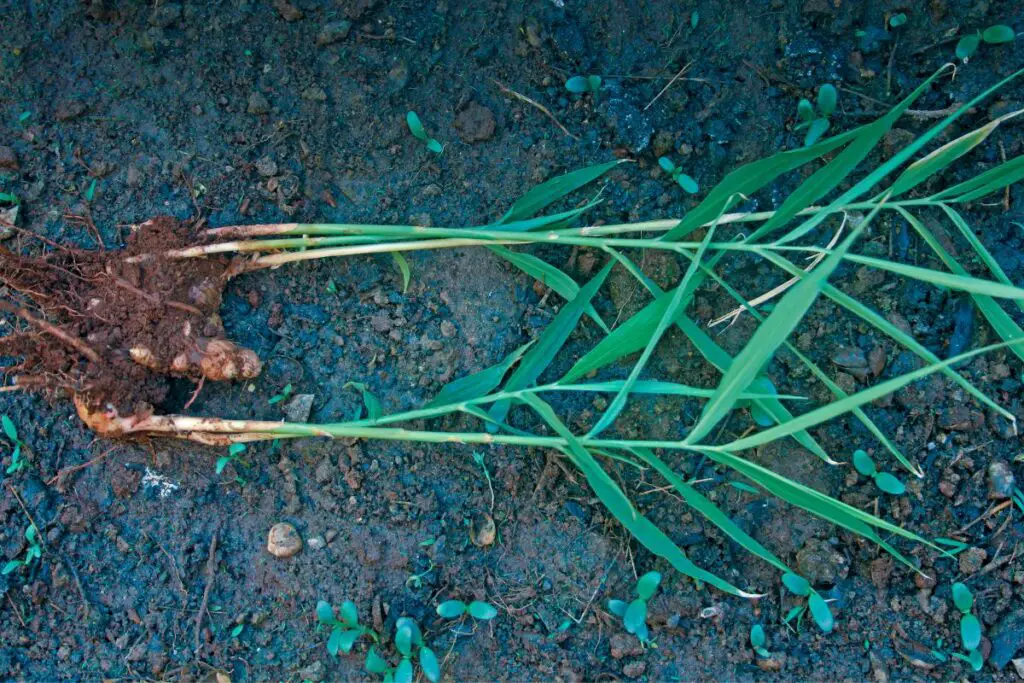
Why doesn’t my ginger plant flower?
There can be various reasons why your ginger plants don’t flower.
Here are some:
1. Insufficient sunlight
Gingers grow best under filtered or dappled sunlight.
Some gingers will also stay fine in shady gardens under the tall trees.
But, if you want the gingers to produce flowers, you must ensure they receive at least 2-5 hours of direct sunlight per day.
The morning sun is mild and less intense, so it will not cause any harm to your ginger plants.
It will be perfect for your ginger plants, thus encouraging the plant to have lovely multicolored flowers.
If the plant doesn’t receive any direct sunlight but only filtered sun or shade throughout the year, you will not see any flowers in your plant.
When the time comes, you only get the rhizomes.
So, if you want your ginger to flower, plant them at a location where they can get at least 2-5 hours of the direct morning sun and then partial shade or dappled sun throughout the day.
2. Frost damage
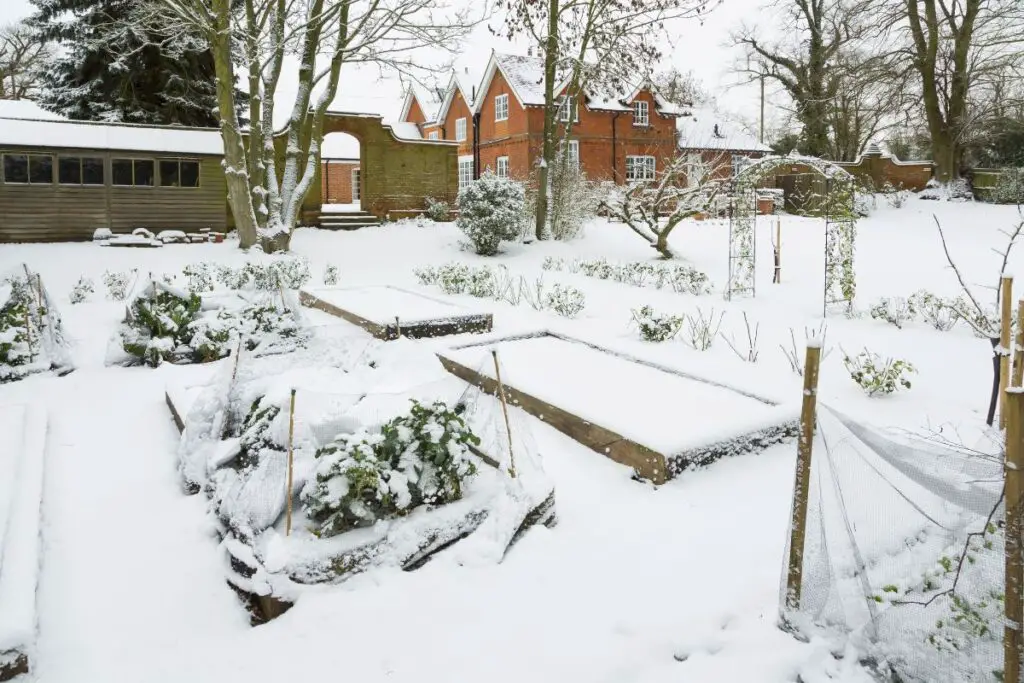
Gingers enjoy growing in warm weather where the temperature remains around 75-85°F.
They grow best when the soil temperature stays about 75°F.
Temperatures below 50-60°F will harm the plants and the rhizomes.
The cold enters the rhizomes, damages their cells, and affects their energy preservation technique.
If this happens, the rhizomes will not have any flowers.
Even if you store these rhizomes, they will face difficulty in sprouting.
If you want your gingers to have flowers, you must protect them from the cold temperature.
When winter arrives, take them indoors if your plant is in pots.
If they are on the grounds, remove the plants above the soil surface, and collect and store the rhizomes in a dark and cool place.
It keeps them safe, allows them to preserve energy for the next year, and prevents sprouting.
Again replant these in the next year and give them enough light to see them have colorful aromatic blooms.
Looking for gardening supplies? We have tested 100's of products before recommending them to you guys. Check out our best pick below:
| Image | Gardening Supplies | Best Price? |
|---|---|---|
 Top
Top Top
Top | Raised Garden Bed Kit | Check On Amazon |
 | XLUX Soil Moisture Meter, Plant Water Monitor, Soil Hygrometer Sensor for Gardening, Farming, Indoor and Outdoor Plants, No Batteries Required | No Results |
 Top
Top Top
Top | 82 Pcs Garden Tools Set and Extra Succulent Tools Set | Check On Amazon |
 | Joeys Garden Expandable Garden Hose with 8 Function Hose Nozzle, Lightweight Anti-Kink Flexible Garden Hoses, Extra Strength Fabric with Double Latex Core, (50 FT, Black) | No Results |
 Top
Top Top
Top | Dual Chamber Compost Tumbler | Check On Amazon |
 Top
Top Top
Top | Sunnyglade Plant Stakes | Check On Amazon |
 Top
Top Top
Top | Organic Cold Pressed Neem Seed Oil | Check On Amazon |
 Top
Top Top
Top | Mighty Mint Gallon :-Insect and Pest Control Peppermint Oil | Check On Amazon |
 Top
Top Top
Top | Scotts DiseaseEx Lawn Fungicide | Check On Amazon |
 Top
Top Top
Top | Jacks Classic 20-20-20 All Purpose Fertilizer | Check On Amazon |
 Top
Top Top
Top | 30,000 Seeds Pollinator Attracting Wildflower Mixture | Check On Amazon |
 Top
Top Top
Top | Survival Vegetable Seeds Garden Kit-Over 16,000 Seeds | Check On Amazon |
3. Immature plant
You did everything right for your ginger plants, but they are still not flowering.
There is nothing to worry about here because some varieties take time to produce flowers.
So, maybe that is why you do not see any flowers in your ginger plants.
You cannot witness any flowers in them until the time has come for the gingers to flower.
They have to reach maturity to produce blooms.
Gingers need at least one year for healthy growth without any disturbances to flower.
Disturbances include problems like light, water, soil, nutrients, or temperature.
The flower stems develop from the mature rhizomes, but shell ginger’s flower stems grow from the leaf stems.
You must wait for at least three years to witness flowers when you grow Ginger from seeds or transplanted plantlets.
The only solution here is to wait and give the plant adequate requirements and time to produce blooms.
Also read: When Is Ginger Ready To Harvest? (+How To)
4. Lack of nutrients
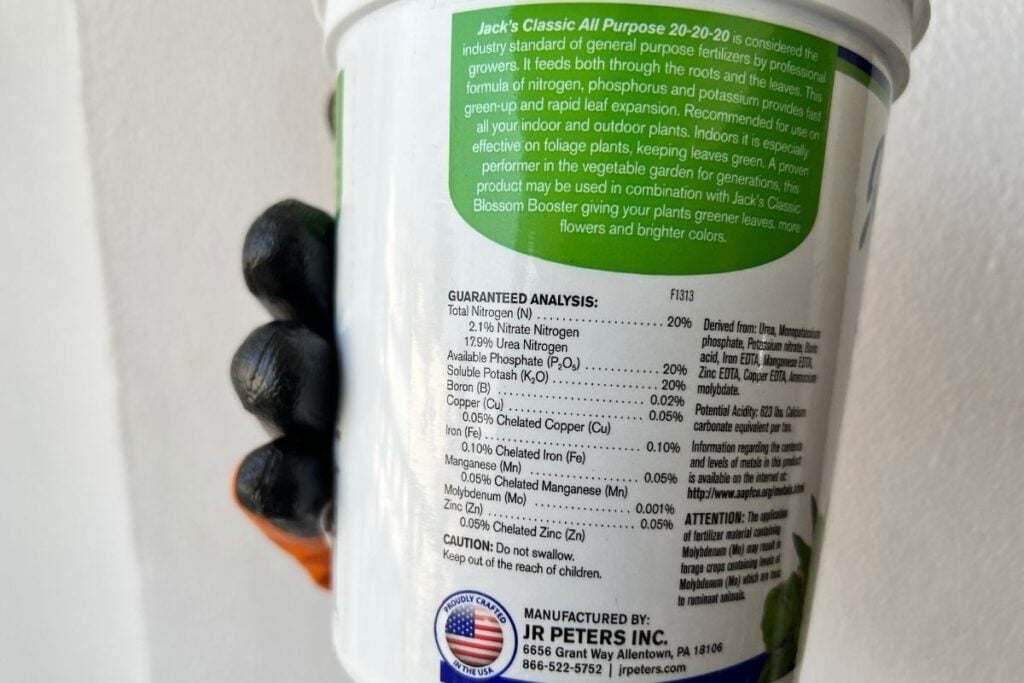
Gingers are very heavy feeders.
They require a lot of nutrients in adequate amounts to survive in the long run.
Lack of nutrition can affect the plant in many ways, including flowering.
Without proper nutrition levels, the plant will not have enough energy to grow well or develop and produce any flowers.
To get flowers from the plant, you must feed them in time.
The rule is to add compost before planting and fertilize the plant with a liquid fertilizer when new shoots appear.
Keep fertilizing throughout the growing season with a 10-20-20 fertilizer.
With proper fertilization, your ginger plants are bound to produce flowers.
But it would be best to stop fertilizing when the flower starts developing.
5. Climatic zones
Gingers grow best in hotter climates than in colder climates.
They get enough heat, light, and warm temperature, inspiring the plant to grow at its best and produce flowers.
However, that doesn’t mean you cannot grow them in the colder zones.
Some rules include growing them in pots to bring them inside or digging up in-ground rhizomes to store them inside in winters.
You may witness late or no flowers if you grow them in the colder zones.
The weather remains cool most of the year, and gingers need warm weather to develop well.
Ginger grows very slowly in such zones and takes one year to reach maturity due to low-intensity sunlight and warmth.
If you want the ginger plants to mature and flower, grow them in pots and take them inside in winter.
Let them have enough sunlight, less watering, and no fertilizing.
This way, your plant can take less than one year to mature. So, you can see flowers in them.
There is no solution or guarantee of flowering even if they get adequate light and nutrients.
You may wait, but don’t keep any high expectations.
6. Underwatering
When you cut the ginger open, you will see that the rhizome is full of moisture.
So, this is an indication that gingers require a lot of moisture content to survive and stay healthy.
Gingers need regular watering.
Without adequate moisture levels in the soil or around the plant, the rhizomes will dry out, and the plant will suffer dehydration.
Dryness affects both growth and flowering.
Gingers cannot endure drought conditions.
So, when you water the plant, ensure you water it when the soil surface is dry. Don’t let the whole dry out.
Water them at least once per week to maintain consistently moist soil.
Also, mist the plants regularly to keep them close to the moisture source.
Water the plant early in the morning to hydrate the ginger plants throughout the day, even during hot and dry weather.
7. Low humidity levels
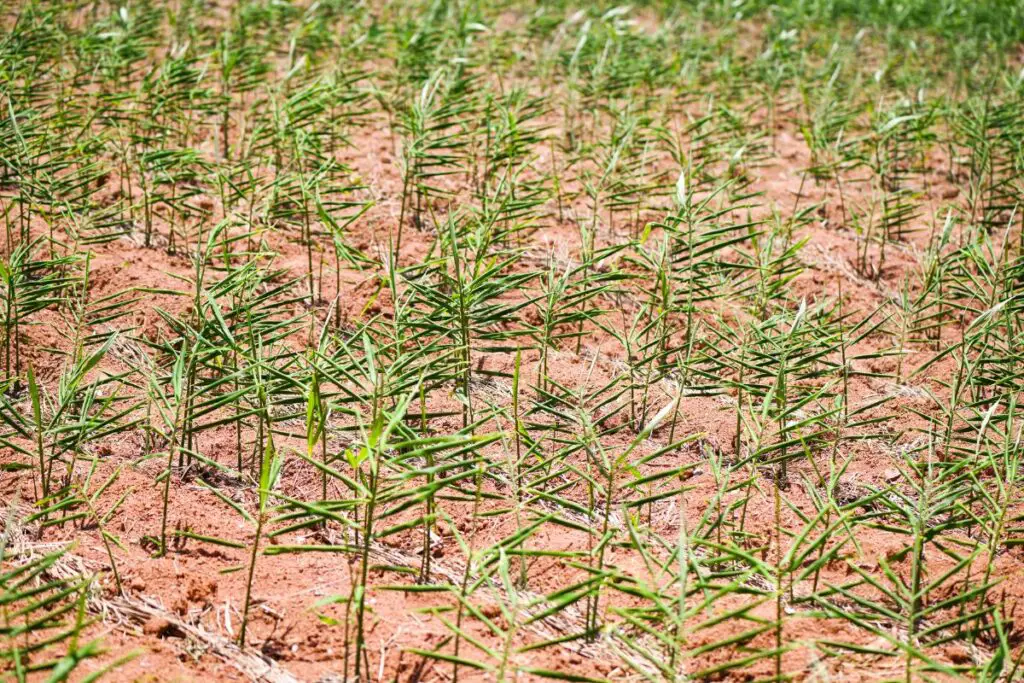
Gingers are from tropical and subtropical areas and need around 70-90% humidity.
Gingers love moisture and can’t tolerate dry weather conditions.
Dry surroundings disturb the plant’s normal growth and affect growth and flowering.
To maintain the right amount of humidity levels, mist the plant regularly.
Another effective and easy method is mulching.
Add a layer of mulch around the ginger bed to trap the moisture in the soil and keep them moist most of the time.
If you are using pots, keep a pebble tray under each pot.
As the water evaporates, it adds moisture to the plant.
Keeping water trays around the plant also works the same way.
8. Wild gingers
Wild gingers are grown in partial or full shade for ground covers.
The variety bears purplish-brown colored flowers.
But most people don’t see these flowers because the blooms are hidden under the evergreen leaves of the ginger plants.
So, people misunderstand and think that the plants are flowering and something might be wrong with them.
The flowers are very small, and the leaves are around 4 inches in size.
Another ginger variety is upright wild Ginger, a Chinese variety.
These plants produce tiny yellow flowers in the spring.
Since they are small and remain under the leaves, the growers might not notice them and misunderstand the situation as some problem.
If you are doing everything correctly but don’t see any flowers, consider checking the plant closely and find the flowers.
These gingers are hardy to zones 4-8 and grow about 3 feet tall and wide.
How to care for the ginger plants?
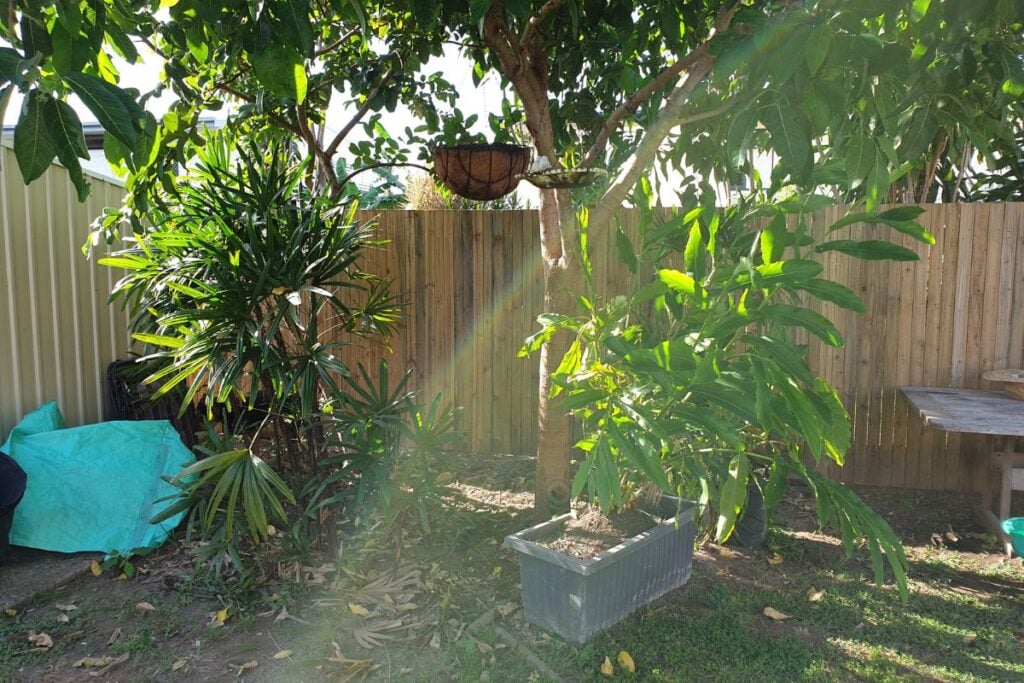
There are some tips to care for ginger plants and encourage them to flower:
- Let ginger plants have 2-5 hours of direct sunlight in the early morning. It doesn’t give the plant sunburns and also encourages them to flower.
- Water the plant regularly, at least 1-2 times per week. Don’t allow the whole soil to dry before watering. Also, make sure you don’t create a pool around the plant. That can also affect flowering.
- Use well-drained, fertile, and loamy soil to help the plant grow at its best and produce flowers. You can also use compost soil or potting mixes that are good for drainage, fertility, and retention.
- Add compost to the soil before planting to make it fertile. Again when new shoots emerge, feed the plant with a 10-20-20 liquid fertilizer once a month in spring and summer. Stop it when the flower emerges.
- Protect the ginger plants in colder climates.
- If you are from colder zones and want your ginger plants to flower, grow them in pots, take them inside in winter, and give them enough light and water to mature them fast.
- Make sure ginger plants get proper humidity levels around 70-80%.
Final thoughts
Gingers are very easy to grow once you know the right care requirements. These care tips will also encourage your plant to have flowers. Ensure your plant gets 2-5 hours of direct sunlight daily, regular watering, warm temperature, high moisture, and proper nutrients.
The plant will take time to mature if you live in colder zones. So, it will be late in flowering. Some gingers take time to mature and flower, and it is natural. In that case, there is no such problem. You have to wait for the plant to mature.
If your plant has received frost damage this year, it will neither sprout nor produce any flowers in the next growing season.
Reference: Ginger Production, Texas AgriLife Extension, USDA, Wikipedia
